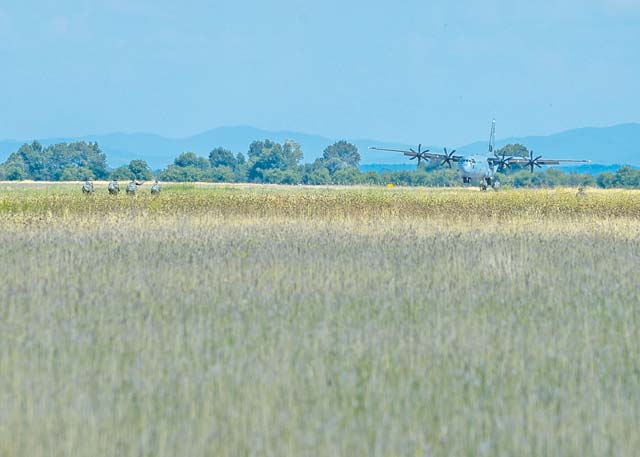
PLOVDIV, Bulgaria — Two U.S. Air Force C-130J Super Hercules aircraft and about 60 Airmen from Ramstein Air Base, arrived at Plovdiv, Bulgaria, July 10 and 11, to kick-off Thracian Summer 2018.
The 37th Airlift Squadron is facilitating the training, scheduled for approximately two weeks, with Bulgarian partners to continue to maintain readiness, trusted relationships, and interoperability. The training will include equipment and personnel airdrops both during the day and night, as well as fighter integration and aeromedical evacuation training.
“Our goal for this exercise is to execute our C-130J training with our Bulgarian partners to validate NATO airlift capabilities and strengthen our relationship,” said U.S. Air Force Capt. Pete Wolber, 37th AS chief of scheduling and Thracian Summer 2018 mission commander. “We will be working on mountainous low-level flying maneuvers, airdrop training, and night vision training for our pilots and loadmasters.”
In addition to the C-130J training opportunities, personnel with the 86th Aeromedical Evacuation Squadron are working on integrating and training with members of the Bulgarian Medical Military Academy.
Other units participating in Thracian Summer 2018 include the 86th Aircraft Maintenance Squadron, the 86th Operations Support Squadron, the 86th Logistics Readiness Squadron, the 435th Contingency Response Group, the 700th Contracting Squadron, the 1st Combat Communication Squadron, the 76th Airlift Squadron, and the 621st Mobility Support Operations Squadron.
“The key during this exercise is the integration of all the roles different units play,” said U.S. Air Force Capt. Jake Jones, 37th AS executive officer and Thracian Summer 2018 deputy mission commander. “We can’t fly without the efforts of each unit.”
While each unit operates together to accomplish the goals of Thracian Summer 18, members work toward building better interoperability with the Bulgarian Military.
“Thracian Summer gives us and our Bulgarian partners the opportunity to learn how we operate, and how we can better work together,” said Jones. “Each of us are expressing our capabilities and improving our ability to work together in case of any real world threats.”













